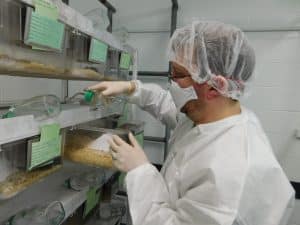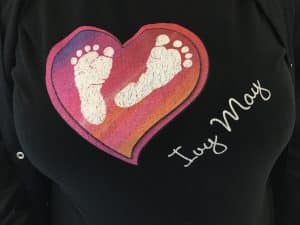When her daughter Ivy was three months old, the baby started experiencing strange symptoms and a lingering fever.

“Every time we touched her she would scream and cry,” Jones remembered. “She didn’t sleep. She didn’t eat. I think one of the most notable symptoms that we knew something was wrong was her eyes. Her scleras weren’t white. They were red.”
That’s one of the hallmarks of a rare illness called Kawasaki disease, named for the Japanese doctor who first described it in the 1960s. Kawasaki also produces rashes. The syndrome affects mainly young children, causing inflammation in the walls of medium-sized arteries, putting patients at greater risk of serious heart trouble later in life.
Dr. Mark Gorelik of CHRISTUS Children’s Hospital of San Antonio and Baylor College of Medicine found Ivy had severe aneurysms on her coronary arteries. She wasn’t responding to conventional therapy. Her diagnosis was delayed after doctors assumed her fever was the result of a routine virus. Dr. Gorelik immediately began treatment.
“It’s a scary time not only for them but I think also for us, you know, for the doctor,” Dr. Gorelik said, “because some of those patients will then go on to have lifelong damage and we don’t know exactly who those patients are going to be.”

Dr. Gorelik isn’t just a pediatric rheumatologist. He’s a scientific researcher. And when he was looking for somewhere to study Kawasaki disease, Texas Biomedical Research Institute gave his animal model and his experiments a place to call home.
“Research institutes like the Texas Biomedical Research Institute are one of those places that bring all of those factors together and allow somebody to spark combustion in science,” he commented.
Jean Patterson, Ph.D., is the scientist who welcomed Dr. Gorelik’s Kawasaki project.
“I just actually approached Jean Patterson out of the blue,” Dr. Gorelik stated. “And I did not know that Jean is a guardian angel.”
“Most virologists, maybe bacteriologists, have always sort of had a passing interest in it just because nobody knows what causes it,” Dr. Patterson said of Kawasaki disease. “And it seems like by now we should have been able to figure it out. It just seems like there’s some mystery here that keeps it really tantalizing and frustrating.”
“We still don’t know at all what causes this disease,” Dr. Gorelik emphasized. “It’s really a complete mystery.”
So Dr. Gorelik and Patterson set out to find funding, which they did, from three different sources: The Voelker Fund Young Investigator Award, the William and Ella Owens Medical Research Foundation, and the Vasculitis Foundation.
Lab mice are one of the keys to studying how to treat Kawasaki more effectively. The goal is to moidfy how the disease progresses.
“We started off obviously with just a few to start them up and now we probably have in the range of 120 mice,” Gorelik explained.
The animals are bred to and given an extract of bacteria that causes them to develop the symptoms of the Kawasaki in about two weeks’ time. Gorelik is using new technology to manipulate a gene and look at its impact on one particular protein that may be involved in damage to blood vessels.
“It’s amazing the kind of technology that exists nowadays that you can actually sort of turn on something to clip out a very precise set of DNA and then the protein goes away,” he said.
With the animals, labs, technology and personnel in place, Dr. Patterson says Texas Biomed was a good fit for a collaboration with CHRISTUS. “For one thing, we have great veterinarians and great veterinarian care. And he had a mouse model so it was easy enough for us to take it on,” she observed.
And Dr. Patterson likes his scientific angle that deals with the effects of the disease itself.

Ivy is no longer suffering. And Dr. Gorelik credits her recovery to a therapy crafted from insights made from research. Her grateful mother feels positive that doctors and scientists are working hard to solve part of the Kawasaki mystery. “To gain more knowledge on this disease and its etiology, that’s amazing for him to do,” jones said.
“She’s basically your normal little near one-year-old,” Dr. Gorelik said as he grinned. And she won’t have to be on blood thinners with restricted activity for the rest of her life.
This is one of more than 200 research project going on at the Institute right now. We’re Texas Biomed. We’re leading the fight against infectious diseases. And we’re enhancing lives through discovery.